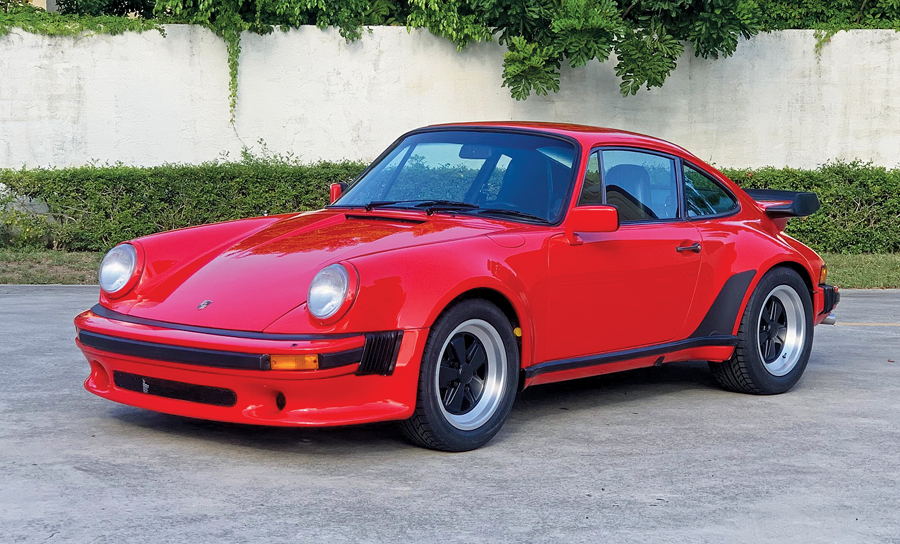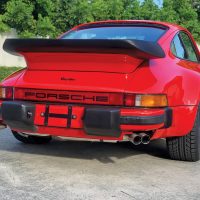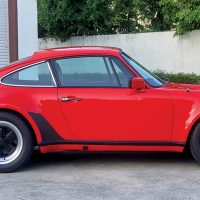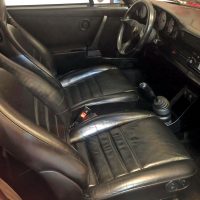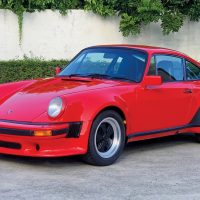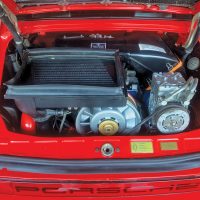SCM Analysis
Detailing
| Vehicle: | 1978 Porsche 930 Turbo |
| Years Produced: | 1975–79 (930 generations 1 and 2) |
| Number Produced: | 1978, 1,287; all 930s 1975–89, 20,685 |
| Original List Price: | 1978, $36,700 |
| SCM Valuation: | $94,500 |
| Tune Up Cost: | $2,750, including valve adjustment |
| Chassis Number Location: | Label on driver’s B-pillar; tag inside windshield; center of panel above gas tank |
| Engine Number Location: | Fan support upright, passenger’s side |
| Club Info: | Porsche Club of America |
| Website: | http://www.pca.org |
| Alternatives: | 1978–83 Porsche 911 SC 3.0-liter, 1978–82 Porsche 928, 1983–85 Ferrari 308 GTB/GTS |
| Investment Grade: | B |
This car, Lot 672, sold for $81,400 including buyer’s premium, at Barrett-Jackson’s Northeast Auction in Uncasville, CT, on June 29, 2019.
Supercharging and turbocharging go way back
Crankshaft-driven supercharging and exhaust-driven turbocharging go back to the early 1900s. These power-increasing measures were predominantly used on race cars, luxury cars, airplanes, or big equipment for 50 years, until General Motors introduced the Chevrolet Corvair Monza and the Oldsmobile Jetfire in the early 1960s.
In the early 1970s, former Porsche-BMW-Ferrari engineer Michael May sold over 4,000 turbocharger kits for 2.3-liter V6 Capris, producing an increase from 108 to 180 horsepower DIN. BMW introduced the 2002 Turbo in late 1973, but in a run of just 1,672 cars. High costs and emissions laws killed that car.
Porsche had experience with supercharging dating from the Auto-Union “Silver Arrow” race cars in the 1930s. Three decades later, in 1969, Porsche built a 2.0-liter turbocharged 911 engine — but shelved it. Later, Porsche bought a Michael May Capri kit and was unimpressed.
Then in 1972, new Porsche President Ernst Fuhrmann — father of the 1950s–1960s 4-cam, 4-cylinder high-performance engines — had a 2.7-liter turbo engine built for his personal 911.
That car gave direct birth to the 930, shown with a dummy wood engine at the October 1973 Frankfurt Auto Show. A fully operational example followed for the Paris Auto Show in October 1974.
The 930 was not a track-ready performance car
The Porsche 930 was launched in 1975 in Europe and 1976 in North America.
Porsche management decreed that the 930 would be a fully loaded luxury car with a price to match. It came standard with air conditioning, AM/FM stereo, power windows, and — in North America — full leather. The car weighed 300 pounds more than a 911, 70 pounds of that in the engine. It was 80% more expensive at $25,880 for the Turbo vs. $13,845 for the 911.
The 930 looked the part, with muscular fender flares over wider wheels and a “whale tail” rear lid. The 2,994-cc engine added 50 more horsepower than Porsche 911s ever had, at 260 in Europe and 234 in North America. The gearbox was a beefed-up 4-speed built from the Type 915 5-speed.
Good performance numbers
Compared to the 911S, the Turbo was 2.5 seconds faster in the 0–60 mph test, at 4.9 seconds. The Turbo was 2.3 seconds faster in the quarter mile, at 13.5 seconds, and 18 mph faster on the top end, at 156 mph. Those numbers attracted road-going speed enthusiasts, even though the 930 was not suited to track use. The early 930 had extreme oversteering characteristics.
For the 1978 model, Porsche did a mild redesign. They increased engine displacement to 3,299 cc, bumped the compression ratio from 6.5 to 7.0 (unboosted), and added an intercooler to get a denser air charge for the turbocharger. Boost remained at 0.8 bar. Horsepower went up to 265 in North America and 300 everywhere else. Wheels already had been increased in size to 16-inch diameter with seven-inch and eight-inch widths in 1977.
Discontinued after 1979 …
That second-generation Turbo lasted through the 1979 model year in North America. More-stringent emissions laws slammed the cars and ended imports.
In the void, used-car dealers and brokers imported gray-market cars and modified them to meet U.S. laws. Of course, franchised Porsche dealers were unhappy about the lost sales. Soon after American Peter Schutz became President of Porsche, he ordered the return of the Turbo to North America.
Those 1986 Turbos carried catalytic converters and yielded 282 horsepower. The reopened North American market led to a doubling of Turbo sales.
One last improvement to the Turbo came in 1989, when the G50 5-speed gearbox was adapted to the 930. After 1989, the Turbo disappeared again — but just for a year — to return as a much different car, the 964 Turbo. The 4-wheel-drive 993 Turbo then replaced the 964. There has been a Porsche Turbo model ever since.
Up-and-down price history
If you were to review the 1975–79 930s in SCM’s Platinum Auction Database, 169 cars strong, you’d see that prices between 1991 and 2005 were often under $20,000, with only exceptional examples over $30,000.
As a rule, 1975–76 cars and 1979 cars have always had higher values. The first $40,000-plus car was in 2008. From 2011 to ’13, prices in the $20ks, $30ks and $40ks predominated — with a high-water mark at $53,000 in 2012, excepting only the Steve McQueen 1976 Turbo.
The Artcurial sale at Le Mans on July 5, 2014, had what was likely the first public sale of a Turbo over $100,000. The first car to break $100,000 in the U.S. was probably at Mecum’s Kissimmee January 2015 sale, a 1978 edition that brought $140,400.
The “King of Cool” had a 930
At Monterey in August 2008, Gooding & Co. sold Steve McQueen’s special-order Slate Gray 1976 930 for a then-whopping $137,500. That sale generated noise, but afterwards, the market smoothly returned to normal.
In August of 2015, Mecum’s Monterey auction brought back the McQueen 930. It sold for $2,145,000, with some of the proceeds going to charity. As an SCM wag commented at the time, that seemed about right: $145,000 for the car and $2,000,000 for McQueen’s sweat. Between those two sales, a McQueen Rolex watch, motorcycle, driver’s suit, and his Slate Gray 911S coupe from the movie “Le Mans” had helped build the McQueen collectible brand.
This time, the market reset
The very next day, a mostly original 1979 930 sold for $302,500 at Gooding’s Pebble Beach Auction. It was painted Light Blue Metallic over a blue leather interior with just 11,000 miles — and a couple of meaningful concours trophies to its credit.
That 2015 Monterey Car Week saw three additional sales at $187,000, $220,000, and $253,000.
In June 2016, Russo and Steele’s Newport Beach auction had a PTS Pearl Yellow Gold 1979 Turbo sell for $216,000. At Monterey in 2016, Mecum sold a 1979 model for $396,000; RM Sotheby’s pulled $275,000 for a 1977 930, and Gooding got $258,500 for a 1976 example. And that one-year run in 2016 was it for über-priced 930s.
For 2017–18, sales were all between $77,000 and $154,000, excepting only two: Bonhams’ Zoute Sale in October 2017 had a restored 1976 Turbo in attractive Sienna Metallic (think copper) sell for $228,872. Then Mecum sold a former Walter Payton-owned 1979 Turbo for $324,500 — not McQueen-like, but a meaningful celebrity premium.
Our Barrett-Jackson 1978 Turbo
Our subject 930 was Guards Red, probably repainted, with unspecified mileage, so it was not low because B-J usually mentions mileages below 50,000 or 60,000 in their catalog write-ups.
The car sold for $81,400, which is in the higher end of the range for driver-quality cars. A rare desirable paint color, very low miles, or high originality will all help to get prices over $100,000 today — even over $150,000.
But the days of 1975–79 930s selling for $200,000 to $300,000 are probably gone for a while — perhaps a long while. ♦
